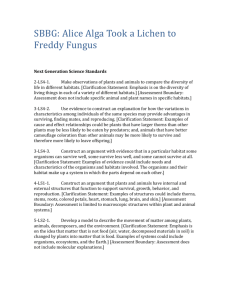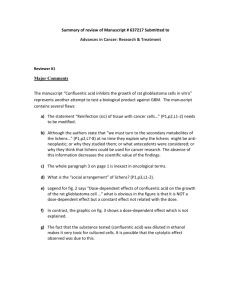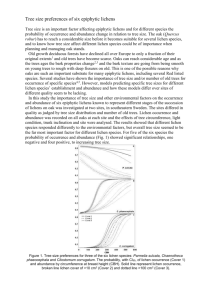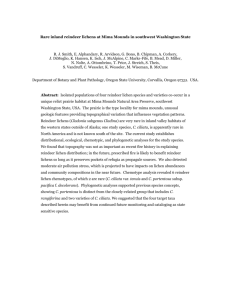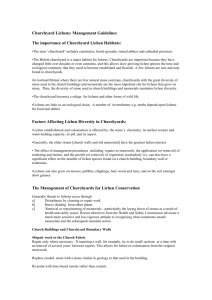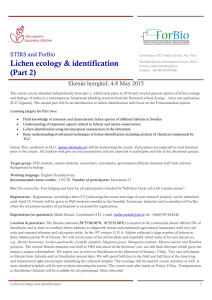Simulating and modeling lichen growth
advertisement
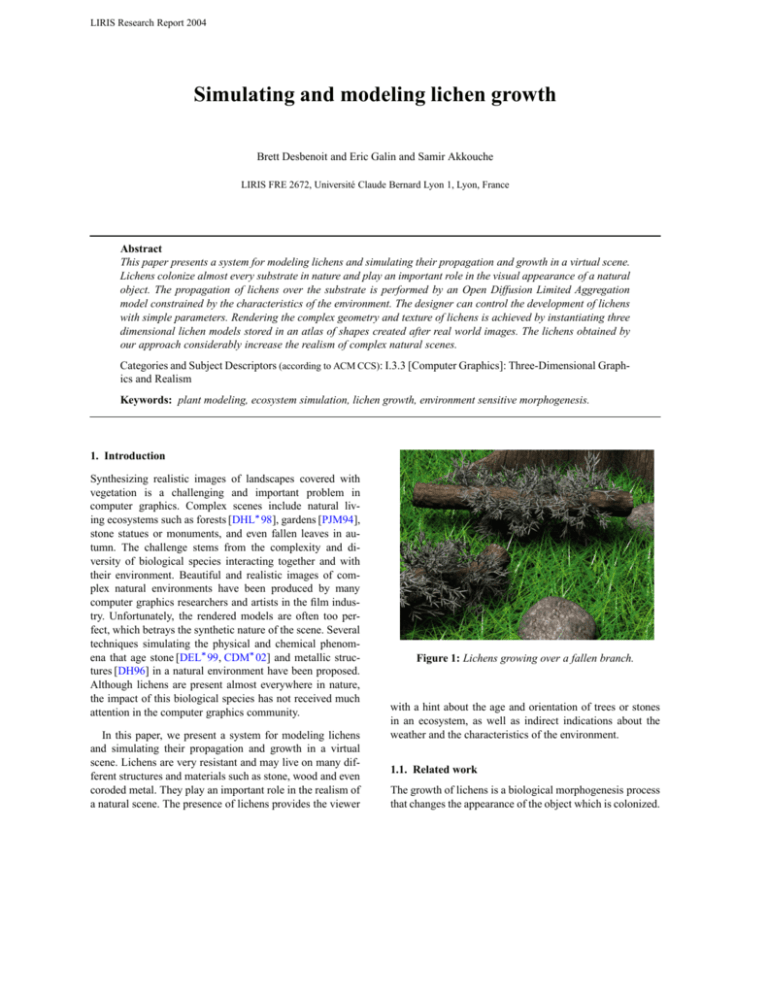
LIRIS Research Report 2004
Simulating and modeling lichen growth
Brett Desbenoit and Eric Galin and Samir Akkouche
LIRIS FRE 2672, Université Claude Bernard Lyon 1, Lyon, France
Abstract
This paper presents a system for modeling lichens and simulating their propagation and growth in a virtual scene.
Lichens colonize almost every substrate in nature and play an important role in the visual appearance of a natural
object. The propagation of lichens over the substrate is performed by an Open Diffusion Limited Aggregation
model constrained by the characteristics of the environment. The designer can control the development of lichens
with simple parameters. Rendering the complex geometry and texture of lichens is achieved by instantiating three
dimensional lichen models stored in an atlas of shapes created after real world images. The lichens obtained by
our approach considerably increase the realism of complex natural scenes.
Categories and Subject Descriptors (according to ACM CCS): I.3.3 [Computer Graphics]: Three-Dimensional Graphics and Realism
Keywords: plant modeling, ecosystem simulation, lichen growth, environment sensitive morphogenesis.
1. Introduction
Synthesizing realistic images of landscapes covered with
vegetation is a challenging and important problem in
computer graphics. Complex scenes include natural living ecosystems such as forests [DHL 98], gardens [PJM94],
stone statues or monuments, and even fallen leaves in autumn. The challenge stems from the complexity and diversity of biological species interacting together and with
their environment. Beautiful and realistic images of complex natural environments have been produced by many
computer graphics researchers and artists in the film industry. Unfortunately, the rendered models are often too perfect, which betrays the synthetic nature of the scene. Several
techniques simulating the physical and chemical phenomena that age stone [DEL 99, CDM 02] and metallic structures [DH96] in a natural environment have been proposed.
Although lichens are present almost everywhere in nature,
the impact of this biological species has not received much
attention in the computer graphics community.
In this paper, we present a system for modeling lichens
and simulating their propagation and growth in a virtual
scene. Lichens are very resistant and may live on many different structures and materials such as stone, wood and even
coroded metal. They play an important role in the realism of
a natural scene. The presence of lichens provides the viewer
Figure 1: Lichens growing over a fallen branch.
with a hint about the age and orientation of trees or stones
in an ecosystem, as well as indirect indications about the
weather and the characteristics of the environment.
1.1. Related work
The growth of lichens is a biological morphogenesis process
that changes the appearance of the object which is colonized.
2
B. Desbenoit and E. Galin and S. Akkouche / Simulating and modeling lichen growth
Our work relates to aging and weathering techniques, and to
environment sensitive plant growth methods.
Aging and weathering Several techniques for modelling
the imperfections and the degradations of an otherwise original object have been proposed. Physically based methods
simulate both physical and chemical phenomena such as
the erosion of stone by water [DEL 99], corrosion in marine environments[CS03], rust formation [MDG01, CS03],
patina covering buried objects [CS00], metallic patinas produced by rain [DH96], cracks [HTK98] and fractures [OH99]. Microscopic phenomena such as the oxidation
of metal generally involve complex simulations that generate a texture that stores the imperfections and changes in
appearance, whereas larger scale phenomena such as fractures, erosion or cracks produce local or global changes in
the geometry of the model. Several procedural approaches
for modelling surface imperfections such has dust accumulation [WNH97] or impacts [EPD01] have been proposed as
well. Contrary to physically based techniques, those methods provide greater control and avoid time consuming simulations.
Ecosystem simulations Simulating the influence of the environment over the development of plants living in a complex ecosystem has received a lot of attention in the computer graphics community. Měch and Prusinkiewicz [MP96]
proposed an Open L-System to model the interactions between plants and the environment. Deussen et al. [DHL 98]
proposed a method that simulates the growth of plants competing for territory. Lane and Prusinkiewicz [LP02] extend
this principle to a whole ecosystem including different types
of plants. The parameters of the environment affect both the
growth of the plants and the spatial distribution of the different species. Recent methods evaluate direct and indirect
lighting accurately and efficiently by hierarchical radiosity
techniques that simulate the radiant energy transfer between
plant models and other objects in the scene [mS02].
Modelling lichens Sumner [Sum] developed a mathematical model based on a Diffusions Limited Agregation (DLA)
model[WS81]. The principle consists in moving a particle
randomly in an area containing an aggregate of particles and
solidifying its position if it gets into contact with the cluster.
This mathematical model makes it possible to create shapes
with a multitude of dendrites organized into a fractal pattern. The proposed method provides some control over the
shape of the one lichen cluster by parameterizing the probability of aggregation by a function of the local curvature.
Unfortunately, this approach does not take into account the
characteristics of the environment and creates almost perfect regular patterns with equally sized lobes that cannot be
found in nature. Moreover, hundreds of thousands of particles are needed to generate a single lichen cluster, which is
both time and memory demanding.
Recently, Cuttler [CDM 02] presented a weathered stone
statue model where lichens were represented by colored particles. Those methods that model lichens as textures fail at
creating convincing realistic images as they do not capture
the complex three dimensional fractal patterns of lichens.
1.2. Contributions
The complexity and diversity of the lichen patterns, shapes
and textures [BSS01] makes modeling every single lichen
thallus by hand impossible. Our approach consists in distributing spores over the objects in the scene, simulating the
lichen propagation to capture the complex distribution patterns of real world lichens, and computing the final complex
geometry using an atlas of textured mesh models for every
kind of lichen. Our contributions are as follows:
Lichen atlases We propose a system for modeling three dimensional lichens after real world images and storing template models into an atlas. Our complex lichen models capture the complexity and diversity of the lichen patterns,
shapes and textures. Lichens colonizing surfaces are instantiated from the template models of the atlas so as to save
memory.
Lichen seeding and propagation We simulate seeding by
dispersing lichen spores over the objects in the scene and
transporting or removing spores that are blown away by the
wind or washed by rain water flows. The propagation of
lichens is performed by an original Open Diffusion Limited
Aggregation (Open DLA) model that captures the development of several lichens influenced by the environment, limited by self collisions and competing for space.
Control The designer may control the patterns formed by
lichen growth by adjusting the biological parameters of the
lichen and its sensitivity to direct and indirect lighting and
moisture. The characteristics of the environment are coded
as texture maps that may be generated either automatically
by physically based simulations, or created by hand by the
designer.
The remainder of this paper is organized as follows.
Section 2 recalls the fundamentals of lichen biology and
presents an overview of the important parameters that influence its development. In Section 3, we describe our lichen
modeling system and address lichen seeding, propagation
and atlas instantiation. Section 4 presents some implementation details of our Open DLA algorithm, as well as timings. Eventually, we show some images illustrating realistic
lichen growth over synthetic objects in complex natural environments in Section 5.
2. Fundamental concepts in biology
Lichens are composite, symbiotic organisms made up from
members of as many as three kingdoms. The dominant partner is a fungus. Fungi are incapable of making their own
B. Desbenoit and E. Galin and S. Akkouche / Simulating and modeling lichen growth
Acarospora
Caloplaca-Inconspecta
Letharia-Vulpina Alectoria-Sarmentosa
Lobaria-Linita Hypogymnia-Heterophylla
Figure 2: Different types of lichens (courtesy of Sylvia
Sharnoff and Stephen Sharnoff).
food and usually provide for themselves as parasites or
decomposers. The lichen fungi (kingdom Fungi) cultivate
partners that manufacture food by photosynthesis. Sometimes the partners are algae (kingdom Protista), other times
cyanobacteria (kingdom Monera), formerly called bluegreen algae.
Classification Lichens are arbitrarily classified into three to
seven growth forms that do not reflect how the lichens are
related to each other. Different species within a genus may
have different growth forms (Figure 2).
Crustose lichens form crusts that are so tightly attached to
the rocks, trees, sidewalks, or soils they grow on that they
cannot be removed without damaging the substrate. Foliose
lichens are somewhat leaf-like, composed of lobes. They
are relatively loosely attached to their substrates, usually by
means of rhizomes. Their lobes have upper and lower sides
and usually grow parallel to the substrate. Fructicose lichens
are the most three-dimensional. They are usually round in
cross section, and most are branched. They can be like little shrubs growing upward, or they can hang down in long
strands.
Lichen growth Lichens grow in the leftover spots of the
natural world that are too harsh or limited for most other
organisms. They are pioneers on bare rock, desert sand,
cleared soil, dead wood, animal bones, rusty metal, and living bark. Able to shut down metabolically during periods of
unfavourable conditions, they can survive extremes of heat,
cold, and drought.
3
Given appropriate amounts of light and moisture, clean
air, and freedom from competition, lichens can colonize almost any undisturbed surface. Most lichens, especially crustose lichens, grow very slowly, often less than one millimeter per year. Fructicose lichens are an exception as they
can grow up to 20 millimeters per year. Lichens grow from
spores that are transported not only by the flow of droplets
of rain and the wind, but also by small animals and insects.
Therefore, spores may be almost transported anywhere, but
the local characteristics of the environment will either favour
or prevent them from springing a new lichen.
Lichens grow very slowly because the photosynthesis is
slowed by the strands of the fungi covering the cells of the
algae which filters incoming light. Therefore, lichens need a
lot of light, although for most species, only indirect lighting
favours growth, whereas strong direct sun lighting burns the
cells and is a limiting factor. Lichens also need water and
moisture to develop, and develop on porous substrates such
as wood or porous stone that retain waters.
3. Modeling and simulating lichen growth
Our goal is to provide the designer with simple tools to
control the location, the distribution pattern and the geometry of lichens in a natural scene. The creation of lichens is
performed in three steps (Figure 3). First, we spread lichen
spores over the objects that will be colonized (Section 3.1).
Then, lichens propagate over the surface, competing for
space and favourable conditions (Section 3.2). Spores are
converted into a particle system constrained to propagate
over the triangle mesh of the colonized objects. The lichen
patterns are obtained by invoking an Open Diffuse Limited
Aggregation (Open DLA) model that takes into account the
characteristics of the environment. Eventually, we create the
complex geometry and texture of lichens (Section 3.3). The
particles spread over the surface of colonized objects are
transformed into textured mesh models by instantiating template lichen models stored in a lichen atlas.
3.1. Seeding lichens
In this section, we address the dispersion of spores that will
develop and propagate colonies over the substrate if the
proper lighting and moisture conditions are met. All those
physical and biological parameters are very hard to simulate. The seeding process is a key step of the algorithm as it
characterizes the distribution of lichens in the scene. Locating spores seeding lichens by hand would be cumbersome
though. We have developed two complementary techniques
for controlling the dispersion of lichen seeds in a virtual
ecosystem.
Wind and water flow simulations In nature, we observe
that most lichens develop on parts of surfaces that are easily
accessible but also protected from gusts of wind and rain
4
B. Desbenoit and E. Galin and S. Akkouche / Simulating and modeling lichen growth
Spores
Particles
Lichen Atlas Models
Seeding
Accessibility
Flow simulation
Propagation
Open DLA
Lighting, water
Create lichen
Lichen atlas
Instanciation
Figure 3: Overview of our lichen growth simulation
flows. We propose a global procedural approach that consists
in randomly dispersing spores in some regions of the scene.
In our system, the designer may control regions where spores
are spawned with bounding spheres.
Figure 5: Seeding regions characterized by painting.
Figure 4: Seed regions and lichen growth using accessibility
and water flow simulations.
lichen symbol was created by constraining spores to areas
painted by the designer.
3.2. Lichen propagation
Spores stick to the surface depending on the characteristics of the substrate, its local geometry, the type of the lichen
and the local accessibility [Mil94] of the surface. A candidate spore that lies in a highly accessible region is removed
to take into account the fact that wind may blown the spore
away. Spores that lie in a region that is hardly accessible are
also removed. Flow simulations may be performed as proposed in [DPH96] to simulate rain washing and transporting
spores. Figure 4 shows a stone colonized by lichens. Spores
may stick to the stone on its side, near the grass, in regions
that are not exposed to the rain and the wind. Spores where
randomly spread in light-blue regions with medium accessibility.
Painting Since the previous approach is computationally
demanding, we propose a second technique that consists in
spreading spores directly over the surface of the objects in
the scene by painting.
The color of the virtual paint defines the local density
of spores. This approach provides the designer with a tight
control over the seeding process. Figure 5 illustrates how a
Our propagation algorithm proceeds in two steps. The first
step evaluates the moisture and lighting parameters over the
surface of colonized objects. Simulations take into account
the trajectory of the sun in the sky hemi-sphere, the dispersion of rain water and moisture sources such as rivers or
lakes. Those parameters are stored in the description of the
objects in the scene graph to speed up future queries.
The second step invokes an Open Diffusion Limited Aggregation (Open DLA) model that distributes particles over
the surface forming a multitude of dendrites organized into
a fractal pattern. The Open-DLA model enables us to capture the development of several lichens influenced by the
environment and competing for space in favourable areas.
Lichens stop growing at the border of unfavourable regions
or when they tend to fold onto themselves.
3.2.1. Characteristics of the environment
Simulating the characteristics of the environment is essential
to obtain a realistic distribution of the lichens in the scene as
well as realistic lichen patterns.
B. Desbenoit and E. Galin and S. Akkouche / Simulating and modeling lichen growth
Lighting Lighting plays a major role in the growth of
lichens. Indirect lighting is favourable to most lichens,
whereas direct lighting limits their development. Therefore,
we create two different lighting maps. Direct and indirect
lighting may be evaluated accurately and efficiently by hierarchical radiosity techniques that simulate the radiant energy
transfer between plant models and other objects in the scene
as proposed in [mS02]. Those methods are complex however, and must be applied to all the objects in the scene.
In our system, we only need to evaluate lighting for objects that will be colonized. Those objects may be easily
identified in the scene graph as the nodes that hold the lichen
spores spread during the seeding step. We rely on stochastic Monte Carlo ray tracing techniques to approximate direct and indirect lighting. The triangles of the meshes are
reorganized into a BSP data structure to speed up computations. We compute the amount of direct light as proposed
in [MP96] by evaluating the integral of the amount of light
coming from the sun in the day. The trajectory of the sun
is discretized into a set of light sources. We avoid aliasing
by using a different stochastic sampling of the trajectory of
the sun after the method presented by Keller et Heidrich
in [KH01].
Moisture Moisture also plays an important part in the
growth of lichens. Lichens are very resistant to drought however, as they are able to shut down metabolically during periods of unfavourable water conditions. Simulating the flow
of rain water in a whole scene as well as the influence of
water sources such as rivers or ponds would be a computationally demanding process though. Therefore, in our system, the moisture map is defined by the user with a three dimensional painting interface that allows him to define which
regions in the scene are wet or dry.
5
Figure 6: Several lichen clusters competing for space.
along the surface. Let p denote a particle, the probability of
aggregation of a particle is characterized by a distribution
function, denoted as p , defined as follows:
p p
p
Theoretical aggregation The probability of aggregation of
a particle, denoted as
p , is a function of the local density of neighbouring particles that characterizes the lichen
pattern without the influence of the environment. Let n p
denote the number of neighbouring particles, we rely on the
following distribution function that follows the Pareto law
(rich get richer):
2
1 α e σ n p τ
The number of particles n p is evaluated by searching the
p α
number particles within a distance ρ of p. The parameter ρ
has an influence over the resulting lichen pattern: small values (ρ 2 r) produce compact patterns, whereas large values
(ρ 3 r) create lacy patterns. Figure 7 shows some lichen
patterns that were produced with our system by varying the
control parameters σ, τ and α in the probability of aggregation p and the radius ρ involved in the function n p .
3.2.2. The Open DLA algorithm
We model the propagation of lichen by an original Open
DLA algorithm. In this section, we outline the main characteristics of our Open DLA algorithm, implementation details
are provided in Section 4.
Open DLA model Spores are first transformed into seed
particles that will progressively grow into clusters competing for space and favourable development conditions with
the others. Starting from a seed particle, the Open DLA algorithm incrementally creates a cluster of particles by randomly moving new particles over the mesh and aggregating
them to the cluster whenever they come into contact with a
cluster. Therefore, lichen growth is inhibited by neighbouring lichens that have already colonized a surface. Figure 5-6
illustrates several lichens competing for space: clusters stop
growing at their interface when they come into contact.
We control lichen propagation by evaluating the probability of aggregation of a particle during its random walk
σ=3
τ = 1.5
α = 10 −4 ρ = 2.5
σ=3
τ=3
α = 10−4 ρ = 2.5
σ = 0.3 τ = 2
α = 10 −3 ρ = 2.5
σ = 0.3 τ = 5
α = 10 −2 ρ = 2
σ = 0.3 τ = 4
α = 10 −4 ρ = 2.5
σ = 0.3 τ = 1.5
α = 10 −2 ρ = 2.25
Figure 7: Patterns obtained with different parameters
The parameter σ controls the overall aspect of the pattern:
high values result in non isotropic patterns whereas low values tend create rounded shapes. The parameter τ characterizes the shape of dendrites: the lobes or dendrites are the
more dense as the parameter τ gets higher. Eventually, α is
6
B. Desbenoit and E. Galin and S. Akkouche / Simulating and modeling lichen growth
a bias parameter in the probability of aggregation that forces
particles to stick even if they should have not: higher values
produce thicker dendrites, whereas lower values create thin
strands.
age is an important feature as lichens may have completely
different geometries in their life.
Age
Influence of the environment The environment function,
referred to as p , combines the sensitivity of the lichen to
indirect and direct lighting and moisture parameters that are
evaluated at the center of the particle p:
p
p
min p p p 30%
100%
100%
70%
is equal to 1 if the characteristics of the environment
are favourable at the location of a particle p, and equal to 0
otherwise.
Figure 9: A lichen atlas with different geometric patterns,
figures stand for the relative occurrence probabilities.
Every kind of lichen is characterized by optimal direct
lighting, indirect lighting and moisture conditions. The sensitivity of a lichen to the conditions of the environment is
defined by three functions, denoted as , and
respectively. Those functions return values within interval 0 1 ,
high values mean that conditions are favourable, low values
mean that conditions are unfavourable.
Within each age interval, several models of the same
lichen with different characteristics are represented and
stored in sub-tables according to their orientation (growing
upward or downward) and size. Every model is also characterized by its relative probability of appearance, which can
be provided after biologogical observations.
Crustose
Foliose
Fructicose
Direct lighting Indirect lighting
Lichen instantiation scheme Our lichen instantiation
scheme iteratively transforms the particles of an input cluster into a set of three dimensional textured models that are
instances selected among the collection of models in the corresponding lichen atlas (Figure 10).
Water
Figure 8: Lighting and moisture sensitivity for different
kinds of lichens
Figure 8 shows some sensitivity curves for crustose, foliose and fructicose lichens that were derived from biological
observations. The curves reflect demonstrate that the crustose lichen is more resistant to the direct light than the other
kinds of lichens, whereas the foliose lichen will tend to develop on porous stone or wood substrate that retain moisture.
3.3. Generating the complex shape of lichens
All lichens have very complex color and texture patterns,
which makes procedural modeling very difficult. Our approach consists in modeling a variety of realistic lichens
shapes after images and storing them in a lichen atlas for
every kind of lichen. The particles generated by the lichen
propagation algorithm are instantiated into mesh models
taken from the lichen atlas, which enables us to save memory and create large areas covered by a variety of lichens
efficiently. The instantiation scheme selects models in the
database after the type of the lichen, the age and the relative
orientation of the particle in the cluster.
Lichen atlases A lichen atlas is organized as a table storing
different textured models of the same lichen type that are
classified according to their age (Figure 9). Classification by
Lichen Atlas Models
Instantiated Final Model
Figure 10: The shared reference instantiation process
The selection process proceeds as follows. Given a particle pi , we first select the table in the lichen atlas corresponding to the age of the particle. Then, we select possible models
in the table whose size meet the orientation growth and accessibility requirements. Eventually, we select a model randomly among the different remaining possibilities according
to their relative occurrence probability. The selected model
is instantiated by a shared reference.
Modeling complex lichens We have developed a interactive method for modeling crustose lichens. Crustose lichens
that form almost two dimensional bumpy crusts and shells
are modeled using cellular textures [FLCB95] implemented
as textured height field models.
The editing process begins with the selection of a crustose lichen image. The designer selects interesting feature
B. Desbenoit and E. Galin and S. Akkouche / Simulating and modeling lichen growth
7
Particle representation Particles store geometrical data
characterizing their location over a triangle mesh. A particle is characterized by an index to the lichen cluster and its
age in the creation in the lichen cluster. A particle is constrained to the triangle mesh and is geometrically defined by
its center, radius, and an index to its supporting triangle. A
particle also stores a rotation angle that is used for orienting
the instance of the model in the lichen atlas. The normal of
a particle is simply defined as the normal of its supporting
triangle.
Figure 11: The cellular texture editor for crustose lichens
regions in the image to extract smaller images, and interactively defines a corresponding height field for every small
image. The final cellular texture is obtained by mapping the
sub-image on the height field. Figure 11 shows a screen shot
of the interface of our crustose lichen modeling tool.
Crustose lichens form spots that exhibit a radial distribution. Therefore, young particles close to the border of the
cluster will have a different shape and texture than older particles at the center of the cluster, which enables us to characterize the relative orientation and position of the cellular
textures easily.
Foliose and fructicose lichens that produce three dimensional leaf-like lobes and little shrubs growing upward are
created using specific L-Systems [Lin68]. The corresponding texture map is obtained from real world images.
4. Implementation details
In this section, we present the implementation details of our
optimized Open DLA algorithm. The propagation of lichen
over the surface of the colonized objects is performed by
constraining a particle system to the triangle meshes. Starting from a seed particle, our method incrementally creates a
cluster of particles by randomly moving new particles over
the mesh and possibly aggregating them to the cluster when
collisions occur.
As a lichen cluster may involve hundred of particles, we
need efficient algorithms for moving a particle over the triangle mesh and for detecting the collision between particles.
Triangle mesh representation Triangles meshes are implemented using a half-edge data-structure [CKS98]. In our implementation, a half-edge contains only a reference to a vertex and a reference to its opposite half-edge, which are coded
as integers. Triangles are coded as half-edge triples, and the
next and previous half edges are procedurally defined as suggested in [CKS98] to save memory. This compact half-edge
representation provides us with sufficient topological information for moving a particle over the surface efficiently.
Diffuse Limited Aggregation Let us recall the fundamentals of the DLA algorithm [WS81]. Given a starting particle
denoted as p0 , the algorithm incrementally creates a cluster
of particles by aggregating particles moving randomly over
the surface and that come into contact with the cluster. In
general, new particles are created at a fixed distance R of p0 .
If the particles move to far away from p0 , they are removed
from the simulation.
Death radius
R
p0
pi
pi
Original DLA
Modified DLA
Figure 12: The original and modified DLA algorithms.
This approach is computationally demanding as the particles may have very long and complex movement before a
collision and aggregation occurs with the cluster. Our modified model improves performance by creating new particles
at a small distance from a particle of the cluster. Let denote a cluster of particles, and let r denote the radius of the
particles (Figure 12). Adding a new particle p to the cluster
is performed as follows:
1. Select a particle pi of the cluster randomly and create a
candidate particle p at a distance 2 r ε of particle pi .
2. Move the candidate particle p in a random direction over
the surface with a small distance d.
2.1 If p comes into contact with the cluster , then check
if aggregation occurs using the aggregation probability p
p
p . If conditions for aggregation
are met, stick the candidate particle and add it to the
cluster, otherwise remove it from the simulation.
2.2 If p collides with another cluster, or moves too far
away from pi , remove it from the simulation.
! Step 1 of the algorithm improves speed by adding new
particles not too far away from the existing cluster. ε is a
parameter that guarantees that new particles are created far
away enough from the randomly selected particle pi so that
8
B. Desbenoit and E. Galin and S. Akkouche / Simulating and modeling lichen growth
collision with the cluster should be avoided at the very first
step of the algorithm. In our simulations, ε was set to r 2.
Step 2 1 of the algorithm ensures that the cluster will not develop in regions where the characteristics of the environment
prevent propagation. Step 2 2 of the algorithm performs a
collision detection between growing clusters and simulates
lichens competing for space.
"
#
#
Moving particles efficiently The position of a particle p is
defined by the index i of its supporting triangle T , and by its
center c. Let d denote a normalized random direction vector
in the plane of the triangle T , and l denote the walk distance.
The new position of the particle is computed as follows:
$
%
1. Compute the intersection p between the edges of triangle
T with the ray starting at c and with direction d.
2. If pp
l, then set the final position of the particle to
p l d and terminate.
3. Otherwise, the particle moves outside T , so move the particle to p and set i to the index of the triangle neighbouring T . Let n denote normal of the triangle neighbouring T , the new direction is computed by evaluating the
tangent vector t d n, which defines the new direction d n t in the new triangle. Update the distance
d d
pp and return to Step 1 of the algorithm until
movement ends.
$
& % &('
$
%
$ $* $
+
& %&
$ )$ * $
Collision detection Collision detection between a candidate particle and the particles of the growing cluster is
the most computationally demanding step of the algorithm.
A straight forward approach that checks all collisions between particles has O n complexity, which makes the cluster growth a O n2 process.
T
p
Figure 13: Collision detection between a particle (yellow)
and a subset of the particles of the existing cluster (green).
We reduce the number of collision detection calls as follows. Given a candidate particle p in a triangle T , we only
compute the collision between p and the subset of particles
that lie in the triangles in the 1-ring neighbourhood of T
(Figure 13). We pre-process the triangle meshes to create a
table storing the indexes of the triangles in the 1-ring neighborhood of a given triangle, which enables us to avoid on the
fly topological queries that are computationally expensive.
Timings Table 1 reports timings for propagating lichen particles over a variety of mesh models. The two stones, tree,
mascot and branch models refer to the images shown in Figures 5, 15, 16 and 1 respectively. The number of triangles
of the mesh models, as well as the number of lichen clusters and the overall number of particles involved in the Open
DLA algorithm are also reported.
Triangles
Clusters
Particles
Time
Stone
450
5
505
50
Eurographics
2400
71
2400
483
Tree
450
5
54
1
Mascot
8388
26
2000
150
Branch
8212
24
522
26
Table 1: Timings (in seconds) for propagating lichen particles using the Open DLA algorithm
In most cases, the lichen propagation step may be performed in less than one minute. The only exception to this
is the Eurographics logo (Figure 5) covered with crustose
lichens, which involves many clusters competing for space
and therefore requires many collision detection calls.
5. Results
We applied our method to model several lichens propagating
over trees, rocks and stone monuments. The corresponding
images are shown throughout this document. For reference,
some of the real lichens we attempted to model are shown
in Figure 2. Spreading lichens and controlling their patterns
and geometry in each scene was performed in approximately
half an hour.
Figure 14 shows a stone statue in a garden colonized by
green algae. The parameters of the environment have been
computed automatically. The green algae develop in the regions that are not exposed to the direct light of the sun, and
favour shadow regions.
6. Conclusion and future work
We have presented a model that synthesizes different kinds
of lichens over surfaces. The growth of the lichen is obtained
by using an Open Diffuse Limited Aggregation simulation
that models the propagation of lichens interacting with the
environment and competing for favourable conditions. We
model the complexity of shapes and texture and the diversity of the lichen patterns by instantiating three dimensional
lichens shapes organized in a lichen atlas. We have also proposed some tools to model realistic lichen models after images.
A key feature of our system is its flexibility and control.
B. Desbenoit and E. Galin and S. Akkouche / Simulating and modeling lichen growth
Figure 14: Green algae colonizing a stone statue
9
Figure 15: A complex scene with different types of lichens
colonizing the bark of a living tree, dead fallen branches and
rocks.
Given an input ecosystem description, the designer can either rely on lighting and water flow simulations to automatically compute the regions where lichen will seed and
develop, or directly control lichen growth areas by specific
tools. A vast variety of lichens patterns and shapes can be
synthesized by controlling a few parameters. New kinds of
lichens may be incrementally added in the lichen atlas to
generated complex scenes.
In a near future, we plan to further investigate the creation of some specific lichens such as Alectoria-Sarmentosa
(Figure 2) that hang down in long strands and that cannot be
modelled with our approach. We are also working on lichens
interacting with the environment in an information feedback
loop. In our implementation, only the light and water affect
the lichens: in reality the lichens should reciprocally affect
the environment and change its parameters locally.
Figure 16: The Eurographics’2004 mascot abandonned in
grass for years and colonized by lichens.
References
Acknowledgements
[BSS01]
The authors would like to thank Sylvia Sharnoff and Stephen
Sharnoff for graciously providing the images of real lichens
in this paper. The authors also thank Laurence Boissieux
(INRIA) for providing the 3D model of Hugo.
[CDM 02] C UTLER B., D ORSEY J., M C M ILLAN L.,
M ǓLLER M., JAGNOW R.: A procedural ap-
B RODO I., S HARNOFF S., S HARNOFF S.:
Lichens of North America. 2001. ISBN 0-30008249-5. 2
10
B. Desbenoit and E. Galin and S. Akkouche / Simulating and modeling lichen growth
Proceedings of SIGGRAPH (1995), pp. 239–
248. 6
Figure 17: Lichens developing over a concrete sidewalk border.
proach to authoring solid models. In Proceedings of SIGGRAPH (2002), pp. 302–311. 1, 2
[CKS98]
C AMPAGNA S., KOBBELT L., S EIDEL H.-P.:
Directed Edges - A Scalable Representation for
Triangle Meshes. Journal of Graphics Tools 3,
4 (1998), 1–12. 7
[HTK98]
H IROTA K., TANOUE Y., K ANEKO T.: Generation of crack patterns with a physical model.
The Visual Computer 14, 3 (1998), 126–137. 2
[KH01]
K ELLER A., H EIDRICH W.: Interleaved sampling. In Rendering Techniques 2001: 12 th
Eurographics Workshop on Rendering (2001),
pp. 269–276. 5
[Lin68]
L INDENMAYER A.: Mathematical models for
cellular interaction in development, parts i and
ii. Journal of Theoretical Biology 18 (1968),
280–315. 7
[LP02]
L ANE B., P RUSINKIEWICZ P.: Generating spatial distributions for multilevel models of plant
communities. In Proceedings of Graphics Interface 2002 (2002), pp. 69–80. 2
[MDG01]
M ERILLOU S., D ISCHLER J.-M., G HAZAN D.: Corrosion: Simulating and rendering. In Graphics Interface 2001 (2001),
pp. 167–174. 2
FARPOUR
[Mil94]
C HANG Y.-X., S HIH Z.-C.: Physically-based
patination for underground objects. Computer
Graphics Forum 19, 3 (2000). 2
M ILLER G.: Efficient algorithms for local and
global accessibility shading. In Proceedings of
SIGGRAPH (1994), pp. 319–326. 4
[MP96]
C HANG Y.-X., S HIH Z.-C.: The synthesis of
rust in seawater. The Visual Computer 19, 1
(2003), 50–66. 2
M ĚCH R., P RUSINKIEWICZ P.: Visual models
of plants interacting with their environment. In
Proceedings of 96 (1996), pp. 397–410. 2, 5
[mS02]
[DEL 99] D ORSEY J., E DELMAN A., L EGAKIS J.,
J ENSEN H. W., P EDERSEN H. K.: Modeling
and rendering of weathered stone. In Proceedings of SIGGRAPH (1999), pp. 225–234. 1, 2
M C., S ILLION F. X.: An efficient instantiation
algorithm for simulating radiant energy transfer in plant models. In ACM Transactions on
Graphics (2002). 2, 5
[OH99]
O’B RIEN J., H ODGINS J.: Graphical modeling
and animation of brittle fracture. In Proceedings
of SIGGRAPH (1999), pp. 137–146. 2
[PJM94]
P RUSINKIEWICZ P., JAMES M., M ĚCH R.:
Synthetic topiary. In Proceedings of SIGGRAPH (1994), pp. 351–358. 1
[Sum]
S UMNER R. W.: Pattern formation in lichen.
Ph.D. thesis, Départment of Electrical Engineering and Computer Science, Massachusetts
institute of technology, 2001. 2
[CS00]
[CS03]
[DH96]
D ORSEY J., H ANRAHAN P. M.: Modeling and
rendering of metallic patinas. In Proceedings of
SIGGRAPH (1996), pp. 387–396. 1, 2
[DHL 98] D EUSSEN O., H ANRAHAN P. M., L IN TERMANN B., M ĚCH R., P HARR M.,
P RUSINKIEWICZ P.: Realistic modeling and
rendering of plant ecosystems. In Proceedings
of SIGGRAPH (1998), pp. 275–286. 1, 2
[DPH96]
D ORSEY J., P EDERSEN H. K., H ANRAHAN
P. M.: Flow and changes in appearance. In Proceedings of SIGGRAPH (1996), pp. 411–420. 4
[EPD01]
E. PAQUETTE P. P., D RETTAKIS G.: Surface
aging by impacts. In Graphics Interface (2001).
2
[FLCB95] F LEISCHER K., L AIDLAW D., C URRIN B.,
BARR A. H.: Cellular texture generation. In
[WNH97] W ONG T.-T., N G W.-Y., H ENG P.-A.: A
geometry dependent texture generation framework for simulating surface imperfections.
In Eurographics Rendering Workshop 1997
(1997), pp. 139–150. 2
[WS81]
W ITTEN T., S ANDER L.: Diffusion-limited aggregation, a kinetic critical phenomenon. Physical Review Letters 47 (1981), 1400–1403. 2,
7


